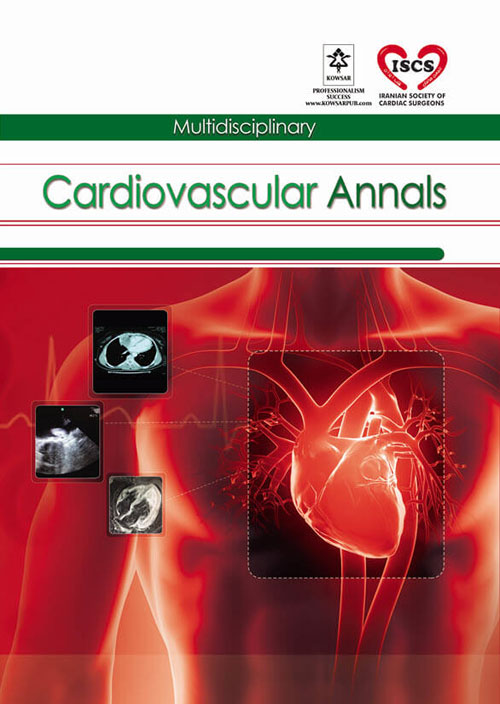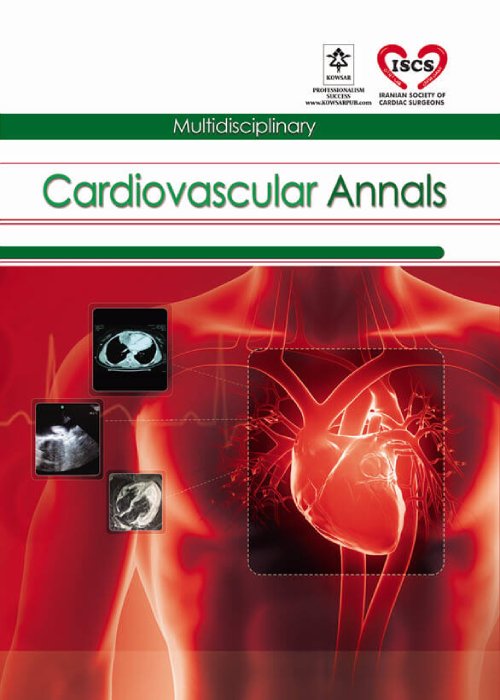فهرست مطالب

Multidisciplinary Cardiovascular Annals
Volume:12 Issue: 2, Jul 2021
- تاریخ انتشار: 1400/05/13
- تعداد عناوین: 8
-
-
Page 1Background
Warfarin is the most commonly used oral anticoagulant for patients with atrial fibrillation, prosthetic heart valves, and deep vein thrombosis with a narrow therapeutic index. Due to the importance of patients’ adherence to treatment and also regular measurements of International normalized ratio (INR), this can have a significant impact on the quality of anticoagulation control.
ObjectivesThe primary aim of this study was to assess the association between warfarin knowledge and time in therapeutic range (TTR) in patients on warfarin anticoagulation for at least 6months who were referred to anticoagulation clinic in Rajaie Heart Center during 2016 - 2017.
MethodsIn this cross-sectional study, 620 patients who had been referred to the outpatient Rajaie Hospital anticoagulant clinic and had been taking warfarin for over six months were asked to fill two questionnaires named anticoagulation knowledge assessment (AKA) during a 12-week period. After obtaining the necessary permits, TTR (by Rosendalmethod) was calculated using the INR results of patients.
ResultsA total of 620 patients completed the questionnaire. The relation between warfarin knowledge and anticoagulation control was not significant. The mean age of the study population was 52.45 SD ± 14.01 years. This study showed a significant relationship between TTR, duration of warfarin usage (PV = 0.03) and the underlying cause of this usage (PV = 0.016).
ConclusionsPrevention of chronic diseases is one of the most important priorities of the health care systems. Reduction in complications such as thrombosis and bleeding can be achieved by efforts to promote patient’s knowledge. By recognition of relation between warfarin knowledge and social and demographic indicators, patient’s education gap can be detected and also planned for dissolving. This study showed that although many of the patients visited in anticoagulation clinic have poor anticoagulation control, but a major part of them have good knowledge of warfarin usage.
Keywords: Knowledge of Warfarin, Heart Disease, TTR (Time in Therapeutic Range), INR -
Page 2Introduction
Arteriovenous malformations (AVM) are rare chronic congenital diseases whose nature are not yet fully understood. Two different types of these disorders are pulmonary and brain malformations, which are seen sporadically or in combination with other syndromes. Symptoms of these diseases appear at different ages and present differently in patients, but in general, the combination of these two disorders is rarely seen. There are several treatments based on the type of lesion and symptoms and other accompanying conditions, one of which is interventional procedure.
Case PresentationIn this article, a rare case of pulmonary and brain malformation has been reported, which has progressed even after treatment and has been closed interventionally.
ConclusionsPatients with pulmonary AVMs need careful examination for other congenital disorders. Furthermore, due to the unknown nature of the disease and its progression, the treatment of these lesions is completely personal and varies according to each patient.
Keywords: Arteriovenous Malformation, Intervention, Cyanosis, Brain Abscess -
Page 3Background
There are various ways to improve the quality of life of social groups. Evaluation of these strategies and improvement of the quality of life of nursing staff should be prioritized by the healthcare administration.
ObjectivesThis study aimed to measure the quality of life and related factors in the nursing staff of three selected hospitals.
MethodsThis periodic descriptive study was conducted on 200 nurses working in three hospitals of Tehran, Iran. The quality of life data were collected using the World Health Organization Quality of Life (WHOQOL-BREF) questionnaire, and the demographic data were collected and analyzed in SPSS for Windows, version 16 (released in 2007, SPSS Inc., Chicago, USA).
ResultsThe average scores of physical, mental, social, and environmental health were measured in this study. Mental health showed the highest score, whereas environmental health had the lowest score. No significant correlation was found between the nurses’ income level and quality of life.
ConclusionsThe environmental and social health scores were significantly higher in married women as compared to men. Also, the score of social health was higher in married nurses, regardless of gender. Therefore, improvement of nurses’ quality of life should be prioritized by health managers in healthcare plans in the light of various factors described in this study.
Keywords: Quality of Life, Health, WHOQOL-BREF -
Page 4Background
Healthcare statistics, issued by various international organizations, show that medical errors in health centers impose high costs on patients and hospitals and increase the rates of morbidity and mortality around the world. Due to the potential risks of cardiovascular diseases, the occurrence of any errors can potentially endanger the patients’ lives and incur costs on them, as well as hospitals. On the other hand, anesthesia is one of the priorities for risk management in clinical care.
ObjectivesThis study aimed to identify, classify, and evaluate anesthesia failures in open heart surgeries, using the healthcare failure mode and effects analysis (HFMEA) technique.
MethodsThe anesthesia process in open heart surgery was reviewed using the HFMEA technique, and four processes, 25 subprocesses, 95 activities, and 204 risks were extracted. The causes of failure were also identified, and four failure modes were determined as the most important failures, based on the qualitative and quantitative methods; finally, some solutions were proposed. Changes in the level of healthcare workers’ knowledge and competence, computer use and timing, and the amount of administered medications were identified as the potential risk factors and errors.
ResultsThe inadequate awareness and knowledge of healthcare workers, non-use of computers, prescription errors, technique errors, and timing and amount of medication administration were identified as the errors and risk factors. Based on the present findings, another expert needs to evaluate the design, feasibility, and prioritization of techniques, including continuing medical education for anesthesia professionals and experts, statutory documentation, and control of the individuals’ activities.
ConclusionsBased on the present findings, establishing a risk management committee seems essential to identify errors and improve the design and plan of different techniques so as to execute, monitor, control, and review errors in a cycle of continuous improvement.
Keywords: Anesthesia, Failure Mode, HFMEA, Cardiac Surgery Process -
Page 5Background
Cognitive impairment is among the most prevalent complications in patients undergoing CABG. Selection of the proper temperature is one of the main moderating factors in cognitive impairment following CABG. Today, heart surgery is done using the two methods of hypothermia and normothermia. However, there is no consensus over the method with the least side effects.
ObjectivesThis study aims to compare the effects of hypothermia and normothermia on cognitive functions after undergoing CABG during the hospitalization period.
MethodsA total of 130 patients in this cohort observational study were divided into two groups of normothermic (n = 65) and hypothermic (n = 65). In the hypothermic group, the temperature was down to 32°C, and in the normothermic group, the temperature decreased to 35°C. After the surgery and transferring the patients to the ICU, demographic information and MMSE questionnaires were completed from the second to the sixth day at the same time.
ResultsThe results showed no significant differences between the two groups in educational and social demographic characteristics (P > 0.05). Besides, there was no significant differences between the two groups in the history of the disease (P = 1.000). In addition, there was no significant relationship between cognitive performance scores of the two groups before the surgery (P = 1.000). However, there was a significant relationship between the two groups from the second (P = 0.003), third (P = 0.000) and the fourth day (P = 0.023) after the surgery. In the normothermic group, on the second, as well as third and fourth days 14 and 9 patients suffered from cognitive impairment, respectively. Besides, in the hypothermic group, on the second, third, and fourth days after surgery, 28, 30, and 23 patients suffered from cognitive impairment, respectively. However, there was no significant relationship between the two groups on the fifth and sixth days after the surgery (P = 0.079).
ConclusionsThe present study showed that during hospitalization after undergoing CABG, cognitive impairment in patients with the normothermic method was less severe than that in patients with the hypothermic method. Besides, clinical outcomes were more satisfactory in the former group.
Keywords: Cognitive Impairment, CABG, Normothermia, Hypothermia -
Page 6Introduction
Cardiac Hydatidosis is a rare and ominous complication of hydatid disease. Cardiac echinococcosis may be asymptomatic for several years but could be discovered after the development of lethal complications.
Case PresentationA 31-year-old-male referred with possible diagnosis of acute pericarditis. Abdominal and pelvic spiral CT scan showed focal and heterogeneous increased thickness of lateral left ventricular (LV) wall with protrusion into LV and bulging into pericardial space without central enhancement. His condition deteriorated suddenly due to cardiac tamponade with round cystic lesions suspected to hydatid cyst. Cardiac magnetic resonance imaging showed some round particles within effusion suggestive of possible scolex around the LV. There was round, and inhomogeneous cystic mass originated from sub-epicardial layer of mid-lateral LV that protruded into pericardial space. Diagnosis of hydatic cyst was confirmed by surgical specimen.
ConclusionsWe suggest that patients with pericarditis should be probed with echocardiography for the presence of hydatid cysts.
Keywords: Ruptured Hydatid Cyst, Tamponade, Pericardial Effusion -
Page 7Introduction
A rare clinical case of coronary artery bypass grafting in congenital chest abnormality with Poland syndrome is described. This syndrome is a congenital anomaly, which is characterized by a combination of unilateral aplasia or hypoplasia of the sternocostal head of the pectoralis major muscle with ipsilateral brachysyndactyly in the classic version. The cause of Poland syndrome is unknown, but it is believed that it can form with a short-term decrease in blood flow in the subclavian and vertebral arteries.
Case PresentationThe presented case shows the possibility of successful completion of coronary artery bypass grafting in Poland syndrome. Revascularization by transluminal balloon angioplasty with stenting reduces the risk of postoperative complications. However, given the degree of damage to the coronary bed and myocardium, in some cases, the patient needs to undergo only coronary artery bypass grafting. The presented case shows the possibility of successful completion of coronary artery bypass grafting in Poland syndrome.
ConclusionsWe believe that, despite the high risks of postoperative complications, patients with Poland syndrome can be recommended to perform a planned operation of coronary artery bypass grafting, including access through a median sternotomy.
Keywords: Thoracotomy, Poland Syndrome, Coronary Artery Bypass Grafting -
Report of the Second Bi-monthly Virtual Meeting of the Iranian Society of Cardiac Surgeons: Investigation of Three Interesting Cases / The Iranian society of cardiac surgeons (ISCS) has been holding a regular meeting every two months since 2005. This is the report of one of the mentioned meetings in which three interesting cardiac surgery cases were presented and discussed.Page 8
The Iranian society of cardiac surgeons (ISCS) has been holding a regular meeting every two months since 2005. This is the report of one of the mentioned meetings in which three interesting cardiac surgery cases were presented and discussed.
Keywords: Persistent Fifth Aortic Arch, Innominate Artery Pseudoaneurysm Cardiopulmonary Bypass, Ventricular Septal Defect, Anomalous Left Coronary Artery Connected to the Pulmonary Artery (ALCAPA)


